
Topeka is the capital city of the U.S. state of Kansas and the seat of Shawnee County. It is along the Kansas River in the central part of Shawnee County, in northeast Kansas, in the Central United States. As of the 2020 census, the population of the city was 126,587. The Topeka metropolitan statistical area, which includes Shawnee, Jackson, Jefferson, Osage, and Wabaunsee Counties, had a population of 233,870 in the 2010 census.

The Maryland State House is located in Annapolis, Maryland. It is the oldest U.S. state capitol in continuous legislative use, dating to 1772 and houses the Maryland General Assembly, plus the offices of the Governor and Lieutenant Governor. In 1783 and 1784 it served as the capitol building of the United States Congress of the Confederation, and is where Ratification Day, the formal end of the American Revolutionary War, occurred.
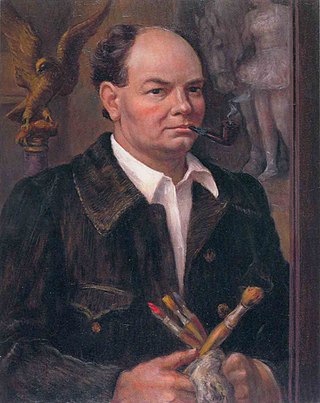
John Steuart Curry was an American painter whose career spanned the years from 1924 until his death. He was noted for his paintings depicting rural life in his home state, Kansas. Along with Thomas Hart Benton and Grant Wood, he was hailed as one of the three great painters of American Regionalism of the first half of the twentieth century. Curry's artistic production was varied, including paintings, book illustrations, prints, and posters.

The Minnesota State Capitol is the seat of government for the U.S. state of Minnesota, in its capital city of Saint Paul. It houses the Minnesota Senate, Minnesota House of Representatives, the office of the Attorney General and the office of the Governor. The building also includes a chamber for the Minnesota Supreme Court, although court activities usually take place in the neighboring Minnesota Judicial Center.

The Nebraska State Capitol is the seat of government of the U.S. state of Nebraska and is located in downtown Lincoln. Designed by New York architect Bertram Grosvenor Goodhue in 1920, it was constructed of Indiana limestone from 1922 to 1932. The capitol houses the primary executive and judicial offices of Nebraska and is home to the Nebraska Legislature—the only unicameral state legislature in the United States.

The Wyoming State Capitol is located in the city of Cheyenne. Cheyenne is the seat of government for the U.S. state of Wyoming. Built between 1886 and 1890, the capitol is located in Cheyenne and contains the chambers of the Wyoming State Legislature as well as the office of the Governor of Wyoming. It was designated a U.S. National Historic Landmark in 1987. The Capitol underwent an extensive three-year renovation and reopened to the public on July 10, 2019.
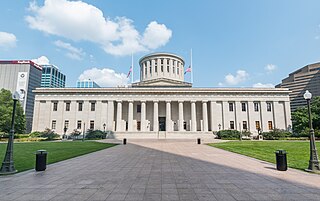
The Ohio Statehouse is the state capitol building and seat of government for the U.S. state of Ohio. The Greek Revival building is located on Capitol Square in Downtown Columbus. The capitol houses the Ohio General Assembly, consisting of the House of Representatives and the Senate. It also contains the ceremonial offices of the governor, lieutenant governor, state treasurer, and state auditor. Built between 1839 and 1861, it is one of the oldest working statehouses in the United States. The statehouse grounds include two other buildings, the Judiciary Annex or Senate Building, and the Atrium; the three are collectively referred to as the Ohio Statehouse into the present day.

The Utah State Capitol is the house of government for the U.S. state of Utah. The building houses the chambers and offices of the Utah State Legislature, the offices of the Governor, Lieutenant Governor, Attorney General, the State Auditor and their staffs. The capitol is the main building of the Utah State Capitol Complex, which is located on Capitol Hill, overlooking downtown Salt Lake City.
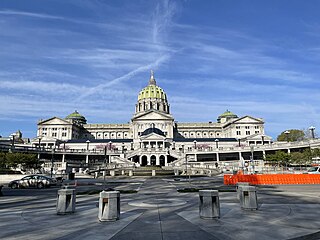
The Pennsylvania State Capitol is the seat of government for the U.S. state of Pennsylvania located in downtown Harrisburg which was designed by architect Joseph Miller Huston in 1902 and completed in 1906 in a Beaux-Arts style with decorative Renaissance themes throughout. The capitol houses the legislative chambers for the Pennsylvania General Assembly, made up of the House of Representatives and the Senate, and the Harrisburg chambers for the Supreme and Superior Courts of Pennsylvania, as well as the offices of the Governor and the Lieutenant Governor. It is also the main building of the Pennsylvania State Capitol Complex.

The Indiana Statehouse is the state capitol building of the U.S. state of Indiana. It houses the Indiana General Assembly, the office of the Governor of Indiana, the Indiana Supreme Court, and other state officials. The Statehouse is located in the capital city of Indianapolis at 200 West Washington Street. Built in 1888, it is the fifth building to house the state government.
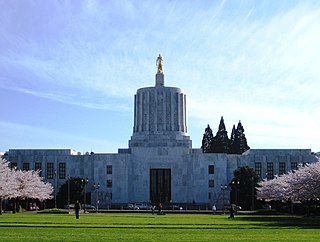
The Oregon State Capitol is the building housing the state legislature and the offices of the governor, secretary of state, and treasurer of the U.S. state of Oregon. It is located in the state capital, Salem. Constructed from 1936 to 1938 and expanded in 1977, the current building is the third to house the Oregon state government in Salem. The first two capitols in Salem were destroyed by fire, one in 1855 and the other in 1935.

The Kansas Legislature is the state legislature of the U.S. state of Kansas. It is a bicameral assembly, composed of the lower Kansas House of Representatives, with 125 state representatives, and the upper Kansas Senate, with 40 state senators. Representatives are elected for two-year terms, senators for four-year terms.

The Kansas Historical Society is the official state historical society of Kansas.

Constitution Hall, in Topeka, Kansas, is a significant building in the history of Kansas Territory and the state of Kansas. The two-story native stone building, with basement, was begun by Loring and John Farnsworth in the spring of 1855. By summer, the Topeka Town Association had agreed to complete the building in exchange for holding the Topeka Constitutional Convention there in the fall. From October 23 to November 11, 1855, the Topeka Constitutional Convention met in the building and produced the antislavery Topeka Constitution.
David Hicks Overmyer was an artist active in the 20th century in Kansas. He is most notable for his murals. His first major commission was in the Kansas State Library building, started in 1934 as part of the Works Progress Administration. The murals which depict the disciplines of K-State at the time, include panels focusing on the concepts of "1) science and industry, 2) agricultural and animal husbandry 3) the arts [and] 4) the home." The preliminary studies for the mural are currently held by the Marianna Kistler Beach Museum of Art on the Kansas State University Manhattan Campus. In 1951, the Kansas Legislature commissioned Overmyer to paint the first floor of the Kansas State Capital building with eight images depicting Kansas history. The scenes are titled The Coming of the Spaniards, Battle of Arickaree, Battle of Mine Creek, Building a Sod House, Lewis and Clark in Kansas, Westward Ho, Arrival of the Railroad, and Chisholm Trail.
Kansas Day is a holiday in the state of Kansas in the United States. It is celebrated annually on January 29 to commemorate the anniversary of the state's 1861 admission to the Union. It was first celebrated in 1877 by schoolchildren in Paola.

Tragic Prelude is a mural painted by Kansan John Steuart Curry for the Kansas State Capitol building in Topeka, Kansas. It is located on the east side of the second floor rotunda. On the north wall it depicts the abolitionist John Brown with a Bible in one hand, on which the Greek letters alpha and omega of Revelation 1:8 can be seen. In his other hand he holds a rifle, referred to as the "Beecher's Bibles". He is in front of Union and Confederate soldiers, living and dead, with a tornado and a prairie fire approaching. Emigrants with covered wagons travel from east to west.
Under U.S. law, a state requires a constitution. A main order of business for Territorial Kansas was the creation of a constitution, under which Kansas would become a state. Whether it would be a slave state or a free state, allowing or prohibiting slavery, was a national issue, because it would affect voting in the polarized U.S. Senate. Because of tensions over slavery, four quite different constitutions of Kansas were drafted.
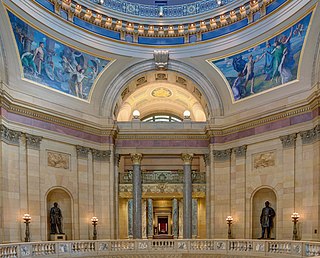
The Minnesota State Capitol opened in 1905 with roughly 60 artworks that totaled $300,000, or 7% of the $4.5-million project budget. Cass Gilbert, the architect of the Capitol building, had envisioned that the artworks would add "educational value" and provide for the "advancement of civilization and intelligence." Over the years, more artworks would be added to the Capitol, totaling nearly 150 by 2017. Much of the Capitol art is allegorical, as expressed through murals and sculptures, while some feature key moments in Minnesota history. While the allegorical symbolism used in the paintings would have been more widely understood during the time they were painted, over time the meanings have been challenged.





















